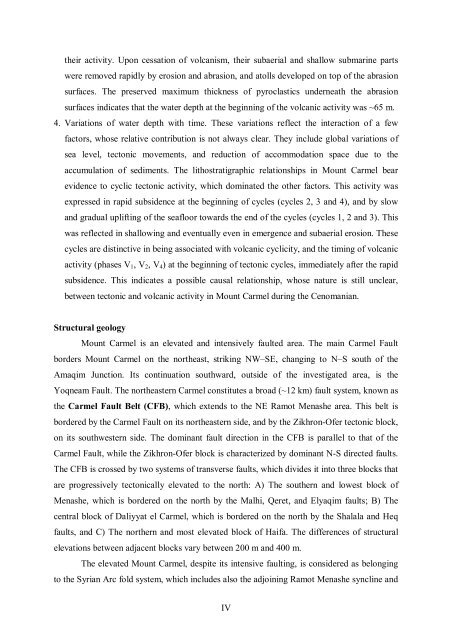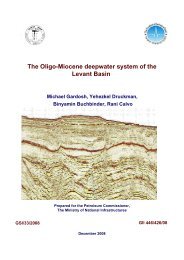×××××××××× ×©× ××ר×× ××××ר×× ××××§× × - Geological Survey of Israel - ××××× ...
×××××××××× ×©× ××ר×× ××××ר×× ××××§× × - Geological Survey of Israel - ××××× ...
×××××××××× ×©× ××ר×× ××××ר×× ××××§× × - Geological Survey of Israel - ××××× ...
Erfolgreiche ePaper selbst erstellen
Machen Sie aus Ihren PDF Publikationen ein blätterbares Flipbook mit unserer einzigartigen Google optimierten e-Paper Software.
their activity. Upon cessation <strong>of</strong> volcanism, their subaerial and shallow submarine partswere removed rapidly by erosion and abrasion, and atolls developed on top <strong>of</strong> the abrasionsurfaces. The preserved maximum thickness <strong>of</strong> pyroclastics underneath the abrasionsurfaces indicates that the water depth at the beginning <strong>of</strong> the volcanic activity was ~65 m.4. Variations <strong>of</strong> water depth with time. These variations reflect the interaction <strong>of</strong> a fewfactors, whose relative contribution is not always clear. They include global variations <strong>of</strong>sea level, tectonic movements, and reduction <strong>of</strong> accommodation space due to theaccumulation <strong>of</strong> sediments. The lithostratigraphic relationships in Mount Carmel bearevidence to cyclic tectonic activity, which dominated the other factors. This activity wasexpressed in rapid subsidence at the beginning <strong>of</strong> cycles (cycles 2, 3 and 4), and by slowand gradual uplifting <strong>of</strong> the seafloor towards the end <strong>of</strong> the cycles (cycles 1, 2 and 3). Thiswas reflected in shallowing and eventually even in emergence and subaerial erosion. Thesecycles are distinctive in being associated with volcanic cyclicity, and the timing <strong>of</strong> volcanicactivity (phases V 1 , V 2 , V 4 ) at the beginning <strong>of</strong> tectonic cycles, immediately after the rapidsubsidence. This indicates a possible causal relationship, whose nature is still unclear,between tectonic and volcanic activity in Mount Carmel during the Cenomanian.Structural geologyMount Carmel is an elevated and intensively faulted area. The main Carmel Faultborders Mount Carmel on the northeast, striking NW–SE, changing to N–S south <strong>of</strong> theAmaqim Junction. Its continuation southward, outside <strong>of</strong> the investigated area, is theYoqneam Fault. The northeastern Carmel constitutes a broad (~12 km) fault system, known asthe Carmel Fault Belt (CFB), which extends to the NE Ramot Menashe area. This belt isbordered by the Carmel Fault on its northeastern side, and by the Zikhron-Ofer tectonic block,on its southwestern side. The dominant fault direction in the CFB is parallel to that <strong>of</strong> theCarmel Fault, while the Zikhron-Ofer block is characterized by dominant N-S directed faults.The CFB is crossed by two systems <strong>of</strong> transverse faults, which divides it into three blocks thatare progressively tectonically elevated to the north: A) The southern and lowest block <strong>of</strong>Menashe, which is bordered on the north by the Malhi, Qeret, and Elyaqim faults; B) Thecentral block <strong>of</strong> Daliyyat el Carmel, which is bordered on the north by the Shalala and Heqfaults, and C) The northern and most elevated block <strong>of</strong> Haifa. The differences <strong>of</strong> structuralelevations between adjacent blocks vary between 200 m and 400 m.The elevated Mount Carmel, despite its intensive faulting, is considered as belongingto the Syrian Arc fold system, which includes also the adjoining Ramot Menashe syncline andIV
















